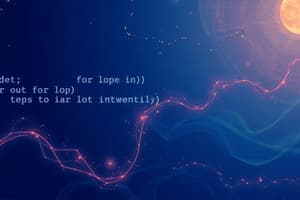Podcast
Questions and Answers
What is the value of 'i' when the loop begins execution?
What is the value of 'i' when the loop begins execution?
- 3
- 2
- 1 (correct)
- 0
What will happen during the first iteration of the loop?
What will happen during the first iteration of the loop?
- The loop will terminate immediately. (correct)
- The value of i will be incremented by 1.
- The loop will execute without entering the if statement.
- The code will print the value of i.
Which of the following statements is true regarding the if statement within the loop?
Which of the following statements is true regarding the if statement within the loop?
- The if statement never gets executed. (correct)
- The if statement will always evaluate to true.
- The if statement causes an infinite loop.
- The if statement will only execute if i is odd.
What will be printed by the code?
What will be printed by the code?
What is the purpose of the 'break' statement in the code?
What is the purpose of the 'break' statement in the code?
What will be the output of the first code snippet that initializes A and iterates through a range of 4?
What will be the output of the first code snippet that initializes A and iterates through a range of 4?
In the first code snippet, what will the value of A be after the loop finishes execution?
In the first code snippet, what will the value of A be after the loop finishes execution?
What will be printed by the second code snippet that uses a while loop with count?
What will be printed by the second code snippet that uses a while loop with count?
For the given boolean expressions in the third code snippet, what will be printed?
For the given boolean expressions in the third code snippet, what will be printed?
In the third code snippet, which conditions evaluate to false for the print statements?
In the third code snippet, which conditions evaluate to false for the print statements?
What will be the output of the following program on execution: print('''tom ... harry''')?
What will be the output of the following program on execution: print('''tom ... harry''')?
What will be the output of the command: print(print(print('python')))?
What will be the output of the command: print(print(print('python')))?
Which operator is used for exponentiation in Python?
Which operator is used for exponentiation in Python?
What is the result of the expression 34 % 3?
What is the result of the expression 34 % 3?
What happens when you attempt to execute: print('tom
sam
harry')?
What happens when you attempt to execute: print('tom sam harry')?
What is the erroneous output for the command: print(”’tomsamharry”’)?
What is the erroneous output for the command: print(”’tomsamharry”’)?
What is the output of the following code: print('this is a number:', 42)?
What is the output of the following code: print('this is a number:', 42)?
Which of the following Python print statements causes an error?
Which of the following Python print statements causes an error?
What will be the output of the code when the 'play' method is called from the Son class?
What will be the output of the code when the 'play' method is called from the Son class?
Why does the code not raise an error when an instance of Son is created and its 'play' method is invoked?
Why does the code not raise an error when an instance of Son is created and its 'play' method is invoked?
What will be the result if arr2 is incorrectly defined in the given NumPy code?
What will be the result if arr2 is incorrectly defined in the given NumPy code?
What is the purpose of the np.concatenate function in the provided code?
What is the purpose of the np.concatenate function in the provided code?
What will be the shape of the array after the concatenation if arr2 is defined as np.array([[9]])?
What will be the shape of the array after the concatenation if arr2 is defined as np.array([[9]])?
What type of class is Father in the provided code example?
What type of class is Father in the provided code example?
How many total methods are defined in the Father class?
How many total methods are defined in the Father class?
If the statement 'print(arr)' is executed and arr is formed by concatenating valid arrays, what will it output?
If the statement 'print(arr)' is executed and arr is formed by concatenating valid arrays, what will it output?
What is the output of the following code? x=2; for i in range(x): x -= 2; print(x)
What is the output of the following code? x=2; for i in range(x): x -= 2; print(x)
In which type of loop can the continue statement be utilized?
In which type of loop can the continue statement be utilized?
What will be the output of the following code? int("Enter value of x:")
What will be the output of the following code? int("Enter value of x:")
What is the output of the following code? for i in range[0, 10]: print("They are equal"); else: print("They are unequal")
What is the output of the following code? for i in range[0, 10]: print("They are equal"); else: print("They are unequal")
What will the output of the following code be? a=5; b=5.0; print('yes') if (a==b) else 'no'
What will the output of the following code be? a=5; b=5.0; print('yes') if (a==b) else 'no'
What is the likely result of attempting to execute the following Python code block? int("Enter value of x:")
What is the likely result of attempting to execute the following Python code block? int("Enter value of x:")
How does the print statement behave in this code? for i in range(0, 10): print("They are equal")
How does the print statement behave in this code? for i in range(0, 10): print("They are equal")
Which of these statements is true regarding the use of float and integer comparisons?
Which of these statements is true regarding the use of float and integer comparisons?
What will be the output of the following code: x = np.where(arr%2 == 1) where arr is defined as np.array([1, 2, 3, 4, 5, 6, 7, 8])?
What will be the output of the following code: x = np.where(arr%2 == 1) where arr is defined as np.array([1, 2, 3, 4, 5, 6, 7, 8])?
What is the output of the following code snippet? print(arr[0,1],arr[1,1]) where arr is defined as np.array([[1,2,3,4,5], [6,7,8,9,10]])?
What is the output of the following code snippet? print(arr[0,1],arr[1,1]) where arr is defined as np.array([[1,2,3,4,5], [6,7,8,9,10]])?
What will this code output? obj = der() followed by print(obj.x, obj.y) if der inherits from A and has its own constructor?
What will this code output? obj = der() followed by print(obj.x, obj.y) if der inherits from A and has its own constructor?
Considering the class structure, what is the purpose of super().__init__() in class der?
Considering the class structure, what is the purpose of super().__init__() in class der?
What will the code block print(x) output after executing x = np.where(arr%2 == 1)?
What will the code block print(x) output after executing x = np.where(arr%2 == 1)?
In the given code, what will happen if y is not provided when creating an object of class der?
In the given code, what will happen if y is not provided when creating an object of class der?
Which of the following statements is correct about the array arr defined as np.array([1, 2, 3, 4, 5, 6, 7, 8])?
Which of the following statements is correct about the array arr defined as np.array([1, 2, 3, 4, 5, 6, 7, 8])?
What will be the output if the following code is run: arr = np.array([[1,2],[3,4]]); print(arr[0][1])?
What will be the output if the following code is run: arr = np.array([[1,2],[3,4]]); print(arr[0][1])?
Flashcards
While Loop
While Loop
A while loop in Python repeatedly executes a block of code as long as a given condition remains True.
Condition in While Loop
Condition in While Loop
The condition in a while loop determines whether the loop continues to execute. It is evaluated before each iteration.
False Condition
False Condition
When the condition in a while loop evaluates to False, the loop immediately terminates and the code execution continues from the next statement after the loop.
Break Statement
Break Statement
Signup and view all the flashcards
Output of the Code
Output of the Code
Signup and view all the flashcards
Print Function Output
Print Function Output
Signup and view all the flashcards
Nested print() Function
Nested print() Function
Signup and view all the flashcards
Power Operator in Python
Power Operator in Python
Signup and view all the flashcards
Modulo Operator
Modulo Operator
Signup and view all the flashcards
Output of Modulo Operation
Output of Modulo Operation
Signup and view all the flashcards
Pass Statement
Pass Statement
Signup and view all the flashcards
Continue Statement
Continue Statement
Signup and view all the flashcards
Logical Operators in Python
Logical Operators in Python
Signup and view all the flashcards
Code Output
Code Output
Signup and view all the flashcards
Abstract Class
Abstract Class
Signup and view all the flashcards
Abstract Method
Abstract Method
Signup and view all the flashcards
Concrete Class
Concrete Class
Signup and view all the flashcards
Inheritance
Inheritance
Signup and view all the flashcards
@abstractmethod Decorator
@abstractmethod Decorator
Signup and view all the flashcards
NumPy concatenate() Function
NumPy concatenate() Function
Signup and view all the flashcards
Axis in NumPy Arrays
Axis in NumPy Arrays
Signup and view all the flashcards
Array Concatenation Output
Array Concatenation Output
Signup and view all the flashcards
NumPy Array Indexing
NumPy Array Indexing
Signup and view all the flashcards
Modulo Operator (%)
Modulo Operator (%)
Signup and view all the flashcards
NumPy where() Function
NumPy where() Function
Signup and view all the flashcards
Inheritance in Python
Inheritance in Python
Signup and view all the flashcards
Overriding Methods in Inheritance
Overriding Methods in Inheritance
Signup and view all the flashcards
Calling Parent Class Methods
Calling Parent Class Methods
Signup and view all the flashcards
Multidimensional Arrays
Multidimensional Arrays
Signup and view all the flashcards
Accessing Elements in Multidimensional Arrays
Accessing Elements in Multidimensional Arrays
Signup and view all the flashcards
For Loop in Python
For Loop in Python
Signup and view all the flashcards
Range Function
Range Function
Signup and view all the flashcards
Output of x -= 2
Output of x -= 2
Signup and view all the flashcards
Conditional Expression
Conditional Expression
Signup and view all the flashcards
Equality Comparison in Python
Equality Comparison in Python
Signup and view all the flashcards
Output of print('yes') if (a == b) else 'no'
Output of print('yes') if (a == b) else 'no'
Signup and view all the flashcards
Type Conversion in Python
Type Conversion in Python
Signup and view all the flashcards
Study Notes
No Topic Provided
- No information was given to generate study notes. Please provide the text or questions.
Studying That Suits You
Use AI to generate personalized quizzes and flashcards to suit your learning preferences.




